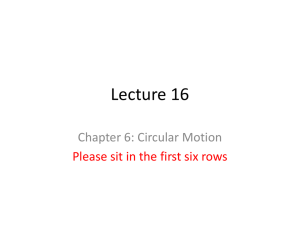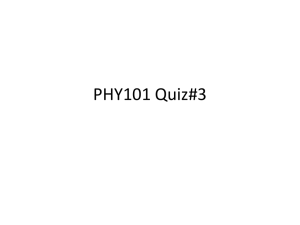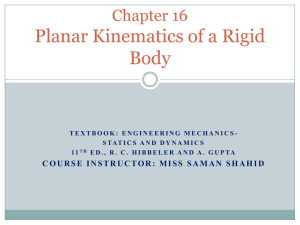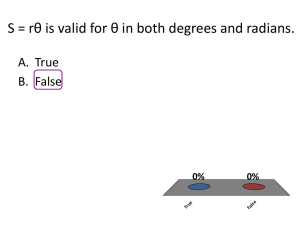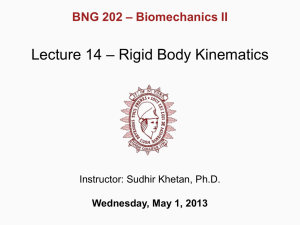Lecture 19.Rotationa..
advertisement
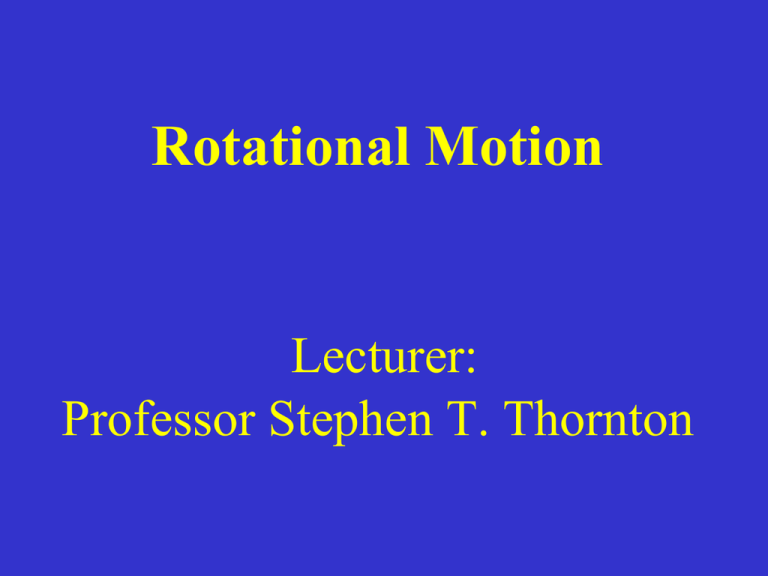
Rotational Motion Lecturer: Professor Stephen T. Thornton Reading Quiz Bonnie sits on the outer rim of a merry-go-round, and Klyde sits midway between the center and the rim. The merry-go-round makes one complete revolution every two seconds. Klyde’s angular velocity is: A) B) C) D) E) same as Bonnie’s twice Bonnie’s half of Bonnie’s 1/4 of Bonnie’s four times Bonnie’s w Klyde Bonnie Reading Quiz Bonnie sits on the outer rim of a merry-go-round, and Klyde sits midway between the center and the rim. The merry-go-round makes one complete revolution every two seconds. Klyde’s angular velocity is: The angular velocity w of any point on a solid object rotating about a fixed axis is the same. Both Bonnie & Klyde go around one revolution (2p radians) every two seconds. A) B) C) D) E) same as Bonnie’s twice Bonnie’s half of Bonnie’s 1/4 of Bonnie’s four times Bonnie’s w Klyde Bonnie Last Time Collisions – elastic, inelastic, perfectly inelastic Center of mass Changing mass - rockets Today Begin angular motion Angular position, displacement Angular speed, velocity Angular acceleration Similarities between translation and rotation Pep Talk Don’t get behind. Halfway through course. Starting most difficult part of course. Rotational motion. Six lectures Angular momentum and torque are the most difficult concepts of this course. Define angular position, velocity, and acceleration – just like we did for translational motion. = angle SI unit: radian (rad), dimensionless One revolution = 3600 = 2π rad Angular Position 0 Arc Length A rc length s r Sign Conventions 0 counterclockw ise rotation < 0 clockw ise rotation 1 rev = 3600 = 2p rad We will mostly use radians. 1 rad = 57.30 A radian is the angle for which the arc length on a circle of radius r is equal to the radius of the circle. r r r Angular Displacement f i angular displacem ent Angular displacement and velocity f i angular displacem ent Just like with velocity, we divide angular displacement by time to find angular velocity. Average angular velocity, wav w av SI unit: radian per second (rad/s) = s-1 t w lim t 0 t d dt Angular Speed and Velocity w 0 counterclockw ise rotation w < 0 clockw ise rotation Vector characteristics Magnitude of angular velocity is the angular speed. But angular velocity is a vector. Use right hand rule to obtain direction of angular velocity. Curl fingers in direction of rotation, and thumb gives direction of angular velocity! (go back and check). Vector direction is perpendicular to screen. Conceptual Quiz: You look at a bicycle as it moves from your left to your right. The angular velocity of the rear wheel is directed A) B) C) D) E) up to the left to the right towards you away from you v Answer: E – away from you Use the right hand rule. The angular velocity is into the screen and away from you. Angular acceleration av w t average angular acceleration S I unit: rad/s s 2 lim t 0 w t = sam e S I unit s dw -2 instantaneous angular acceleration dt 2 Vector direction follows right hand rule. Angular Acceleration A Pulley with Constant Angular Acceleration dw dt w t w w0 w w0 t t w w0 w w0 t N ote: v v 0 at t0 Similarities between linear and angular motion quantities *** x vw a w w0 t v v0 a t x x0 1 2 ( v0 v )t x x0 v0t 1 at 2 2 v v 2 a ( x x0 ) 2 2 0 0 1 2 (w 0 w ) t 0 w 0t w 2 w 2 0 1 t 2 2 2 ( 0 ) Angular Quantities The frequency is the number of complete revolutions or cycles per second: f = w 2p cycles/s Frequencies are measured in hertz: 1 Hz = 1 s - 1 cycles/s The period is the time one revolution takes: T = 1 f Linear to rotational quantities T is period of one revolution. w 2 p rad angular velocity around circle T vt 2p r T 2p r rw T tangential speed vt rw Tangential speed depends on radius. Cooling Fan. A cooling fan is turned off when it is running at 850 rev/min. It turns 1350 revolutions before it comes to a stop. (a) What was the fan’s angular acceleration, assumed constant? (b) How long did it take the fan to come to a complete stop? Conceptual Quiz An object at rest begins to rotate with a constant angular acceleration. If this object has angular velocity w at time t, what was its angular velocity at the time 1/2 t? A) B) C) D) E) 1/2 w 1/4 w 3/4 w 2w 4w Conceptual Quiz An object at rest begins to rotate with a constant angular acceleration. If this object has angular velocity w at time t, what was its angular velocity at the time 1/2t? A) B) C) D) E) 1/2 w 1/4 w 3/4 w 2w 4w The angular velocity is w = t (starting from rest), and there is a linear dependence on time. Therefore, in half the time, the object has accelerated up to only half the speed. Conceptual Quiz An object at rest begins to rotate with a constant angular acceleration. If this object rotates through an angle in the time t, through what angle did it rotate in the time 1/2 t? A) B) C) D) E) /2 /4 3/4 2 4 Conceptual Quiz An object at rest begins to rotate with a constant angular acceleration. If this object rotates through an angle in the time t, through what angle did it rotate in the time 1/2 t? A) B) C) D) E) /2 /4 3/4 2 4 The angular displacement is = 1/2 t 2 (starting from rest), and there is a quadratic dependence on time. Therefore, in half the time, the object has rotated through one-quarter the angle. Centripetal and Tangential Acceleration C entripetal acceleration a cp v 2 ( rw ) r 2 r r w a cp 2 v T angential acceleration Not uniform circular motion vt rw vt r w at vt t r w t r a t Conceptual Quiz Bonnie sits on the outer rim of a merry-go-round, and Klyde sits midway between the center and the rim. The merry-go-round makes one revolution every 2 seconds. Who has the larger linear (tangential) velocity? A) Klyde B) Bonnie C) both the same D) linear velocity is zero for both of them w Klyde Bonnie Conceptual Quiz Bonnie sits on the outer rim of a merry-go-round, and Klyde sits midway between the center and the rim. The merry-go-round makes one revolution every 2 seconds. Who has the larger linear (tangential) velocity? A) Klyde B) Bonnie C) both the same D) linear velocity is zero for both of them Their linear speeds v will be w different because v = Rw and Bonnie is located farther out Klyde (larger radius R) than Klyde. VKlyde 1 2 VBonnie Follow-up: Who has the larger centripetal acceleration? Bonnie Do falling rigid body demo.




